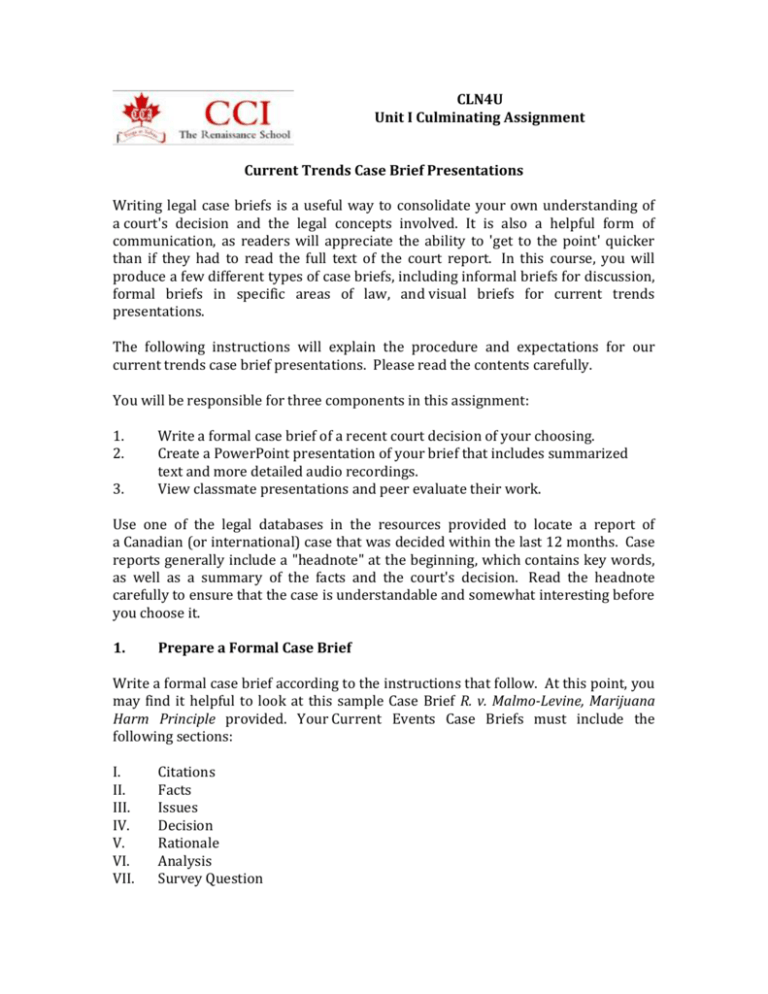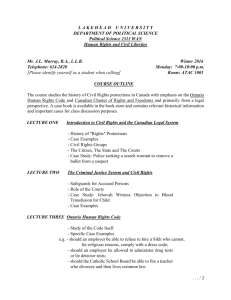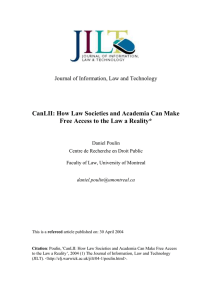File - Canadian College Italy
advertisement

CLN4U Unit I Culminating Assignment Current Trends Case Brief Presentations Writing legal case briefs is a useful way to consolidate your own understanding of a court's decision and the legal concepts involved. It is also a helpful form of communication, as readers will appreciate the ability to 'get to the point' quicker than if they had to read the full text of the court report. In this course, you will produce a few different types of case briefs, including informal briefs for discussion, formal briefs in specific areas of law, and visual briefs for current trends presentations. The following instructions will explain the procedure and expectations for our current trends case brief presentations. Please read the contents carefully. You will be responsible for three components in this assignment: 1. 2. 3. Write a formal case brief of a recent court decision of your choosing. Create a PowerPoint presentation of your brief that includes summarized text and more detailed audio recordings. View classmate presentations and peer evaluate their work. Use one of the legal databases in the resources provided to locate a report of a Canadian (or international) case that was decided within the last 12 months. Case reports generally include a "headnote" at the beginning, which contains key words, as well as a summary of the facts and the court's decision. Read the headnote carefully to ensure that the case is understandable and somewhat interesting before you choose it. 1. Prepare a Formal Case Brief Write a formal case brief according to the instructions that follow. At this point, you may find it helpful to look at this sample Case Brief R. v. Malmo-Levine, Marijuana Harm Principle provided. Your Current Events Case Briefs must include the following sections: I. II. III. IV. V. VI. VII. Citations Facts Issues Decision Rationale Analysis Survey Question I. Citations Traditional Case Citations: A case citation is a simple but standardized form for naming a judicial decision. It provides information to allow the reader to look up the full text of the case themselves and also indicates the importance of the decision. Here are a few colour coded examples: Gauthier v. Naneff (1970), 14 DLR (3d) 513 (Ont. HC) Re Manitoba Language Rights, [1985] 1 SCR 721 R. v. Williams, [1998] 1 SCR 1128 1) Style of Cause: This includes the names of the parties. "Re" is read as "in the matter of", and "v." is read as "and" in a civil matter and "versus" in a criminal matter. 2) Date: Round brackets indicate the year that the case was decided, and square brackets indicate the year of the volume in which it was reported. 3) Volume, Reporter, Series: Abbreviations are used for the different case reporters. For example, DLR refers to Dominion Law Reports, and SCR refers to Supreme Court Reports. 4) Page: The page number follows the volume reference. 5) Court: The court will be indicated in round brackets unless it is obvious from the case reporter. Neutral Case Citations: If a case citation does not seem to fit the structure just described, it may be a "neutral citation". This is a relatively new form of citation that does not identify a law report where the case can be found. Neutral citations make sense since printed case reporters may change over time or even become obsolete due to the Internet. Neutral citations are a permanent reference that will never need to change. They contain three main elements; the traditional style of cause, the core of the citation including the year and court, and the ordinal number attributed to the decision. Ordinal numbers restart with the calendar year on January 1. Example) R. v. Morelli, 2010 SCC 8 TIP: BE CAREFUL! DON'T INCLUDE ANY EXTRA PUNCTUATION/REFERENCES. II. Facts Here you should summarize the relevant facts of the case. They should be presented in a logical and chronological sequence that includes the important events that transpired among the parties and culminates with a brief description of the legal action taken. A case report might include the different statements or interpretations of the facts that are presented by the opposing parties. Facts that are in dispute and never accepted by the court should not be included in your brief; you should only summarize the facts that are agreed upon or proven. The summary of facts should lead smoothly into the statement of the issues that follows. A good summary of facts should include the following: • • • • III. A one-sentence description of the nature of the case, to serve as an introduction. A statement of the relevant law, with quotation marks or underlining to draw attention to the key words or phrases that are in dispute. A summary of the complaint (in a civil case) or the indictment (in a criminal case) plus relevant evidence and arguments presented in court to explain who did what to whom and why the case was thought to involve illegal conduct. If the case is an appeal, include a summary of actions taken by the lower courts; for example: defendant convicted; conviction upheld by appellate court; Supreme Court granted certiorari. Issues The issues are the legal questions that must be determined by the court in order to resolve the dispute. An issue may be one of the following types: Question of Fact: For example, "Did the defendant meet the legal conditions for commission of the crime?" Question of Law: For example, "Can the defendant use a certain legal or commonlaw defence to excuse his actions?" Question of both Law and Fact: For example, "Did the police conduct a valid search of the defendant's premises?" You should also include a brief statement of each party's argument on either side of each issue: Example: "Counsel for the defendant argued that mens rea was not proven because the defendant was not aware of the drugs hidden in his George Bush bobble-head doll." IV. Decision This is a brief, possibly single-sentence statement of the result of the legal action. In a civil case, the court finds in favour of one of the parties, and in a criminal case, the defendant is either convicted or acquitted. V. Rationale The rationale or ratio decidendi of a court's decision is an explanation of the reasoning behind its decisions on the issues; it is often the lengthiest part of a case report. Your job is to summarize this reasoning. Start by focusing on the basis for the decisions; was it stare decisis (in other words based on legal precedent from previous decisions) or was it based on considerations of economics, politics, sociology, fairness, etc..? The reasoning, or rationale, is the chain of argument that led the judges in either a majority or a dissenting opinion to rule as they did. This should be outlined point by point in numbered sentences or paragraphs. TIP: MAKE SURE THAT EACH OF THE STATED ISSUES ARE ADDRESSED HERE. VI. Analysis This is your chance to give your opinions. Evaluate the significance of the case, its relationship to other cases, its place in history, and what it shows about the Court, its members, its decision-making processes, or the impact it has on litigants, government, or society. It is here that the implicit assumptions and values of the judges or justices should be probed, the “rightness” of the decision debated, and the logic of the reasoning considered. VII. Survey Question Conclude your brief with a simple 'yes'/'no' question for the audience at your presentation to answer. This will help your classmates to engage in the material and to think about the significance of the issues involved. 2. Create a PowerPoint Presentation of the Case Brief Transform your written case brief into a PowerPoint presentation that includes a summary of the text and more detailed audio recordings. You don't need to worry about rehearsing! Use these samples as a guide: Video available online at http://youtu.be/tBNwfR6EyqI; PowerPoint: Current Trends Case Brief Presentation - Sample 1.pptx Video available online at http://youtu.be/AD8eC3759GU; PowerPoint: Current Trends Case Brief Presentation - Sample 2.pptx Video available online at http://youtu.be/Lu4c5-JwZ9A; PowerPoint: Current Trends Case Brief Presentation - Sample 3.pptx Video available online at http://youtu.be/Zp6AaxaVpy4 Video available online at http://youtu.be/-bI_rUVUuXY Video available online at http://youtu.be/yKd-WR1VPHo; For more detailed instructions on how to create a PowerPoint presentation that plays automatically, ask for the guide, Tips for Current Trends Case Brief Presentations. Resources Access to Justice Network This site contains easy-to-understand information about Canadian law: http://www.acjnet.org/nahome/ Canadian Broadcasting Corporation This site contains detailed video and audio reports on a wide variety of topics: http://archives.cbc.ca/ Canadian Law Site This is a general resource for Canadian law: http://www.canadianlawsite.ca/ Canadian Legal FAQ's This site answers frequently asked legal questions in plain language: http://www.lawfaqs.org/wiki/index.php/Main_Page Canadian Legal Information Institute This site contains Canadian legal decisions as well as federal and provincial statutes and regulations: http://www.canlii.org/en/ Canadian Superior Courts Judges Association (CSCJA) This site contains information about the judicial system in Canada: http://www.cscjaacjcs.ca/about_cscja-en.asp?l=1 Charter Digest This section of the CANLII website offers a very user-friendly digest of case law related to the Canadian Charter of Rights and Freedoms. It is broken down section by section. Just keep in mind that it is not completely current; you will see the date of the last update on the opening page at; http://www.canlii.org/en/ca/charter_digest/index.html Department of Justice Canada This site provides news, laws, and links to many other legal resources: http://www.canada.justice.gc.ca/eng/index.html Department of Justice Canada - Consolidated Acts and Regulations This source contains the complete text of all federal Acts and regulations: http://laws.justice.gc.ca/en/index.html Duhaime.org This site includes a wealth of information and interesting commentary on Canadian law: http://duhaime.org/ Guide To Ontario Courts This site includes reports of Ontario court decisions, searchable by title: http://www.ontariocourts.on.ca/en/ Human Rights Tribunal of Ontario - Decisions This searchable database at CanLII contains the full text of the decisions of the Human Rights Tribunal of Ontario: http://www.canlii.org/en/on/onhrt/ JURIST Canada This University of Toronto site includes an abundance of information on Canadian and international law: http://jurist.law.utoronto.ca/ LawyerShop This is a commercial site that includes information about issues and developments in different areas of law: http://info.lawyershop.ca/ Library and Archives Canada a variety of legal topics, organized alphabetically: http://www.collectionscanada.gc.ca/caninfo/ep034.htm Ontario e-Laws This site contains the complete text of Ontario statutes and regulations: http://www.elaws.gov.on.ca/navigation?file=home&lang=en SCC.Lexum This site contains the complete text of all judgments of the Supreme Court of Canada: http://scc.lexum.org/en/index.html The Court.ca This website is an initiative of Osgoode Hall Law School and includes discussion of Supreme Court of Canada decisions: http://www.thecourt.ca/ Wikipedia - Law of Canada This is a good source for the basics: http://en.wikipedia.org/wiki/Law_of_Canada










